Potřebujeme váš souhlas k využití jednotlivých dat, aby se vám mimo jiné mohly ukazovat informace týkající se vašich zájmů. Souhlas udělíte kliknutím na tlačítko „OK“.
ASTM C1648-12
Standard Guide for Choosing a Method for Determining the Index of Refraction and Dispersion of Glass
Automaticky přeložený název:
Standardní Průvodce při výběru metody pro stanovení indexu lomu a disperze skla
NORMA vydána dne 1.10.2012
Informace o normě:
Označení normy: ASTM C1648-12
Poznámka: NEPLATNÁ
Datum vydání normy: 1.10.2012
Kód zboží: NS-12112
Počet stran: 15
Přibližná hmotnost: 45 g (0.10 liber)
Země: Americká technická norma
Kategorie: Technické normy ASTM
Kategorie - podobné normy:
Anotace textu normy ASTM C1648-12 :
Keywords:
Abbe-number, dispersion, glass, index of refraction, refractive index, refractometer, ICS Number Code 81.040.30 (Glass products)
Doplňující informace
| Significance and Use | ||||
|
4.1 Measurement—The refractive index at any wavelength of a piece of homogeneous glass is a function, primarily, of its composition, and secondarily, of its state of annealing. The index of a glass can be altered over a range of up to 1×10-4 (that is, 1 in the fourth decimal place) by the changing of an annealing schedule. This is a critical consideration for optical glasses, that is, glasses intended for use in high performance optical instruments where the required value of an index can be as exact as 1×10-6. Compensation for minor variations of composition are made by controlled rates of annealing for such optical glasses; therefore, the ability to measure index to six decimal places can be a necessity; however, for most commercial and experimental glasses, standard annealing schedules appropriate to each are used to limit internal stress and less rigorous methods of test for refractive index are usually adequate. The refractive indices of glass ophthalmic lens pressings are held to 5×10-4 because the tools used for generating the figures of ophthalmic lenses are made to produce curvatures that are related to specific indices of refraction of the lens materials.
4.2 Dispersion—Dispersion-values aid optical designers
in their selection of glasses (Note 1). Each relative partial
dispersion-number is calculated for a particular set of three
wavelengths, and several such numbers, representing different parts
of the spectrum might be used when designing more complex optical
systems. For most glasses, dispersion increases with increasing
refractive index. For the purposes of this standard, it is
sufficient to describe only two reciprocal relative partial
dispersions that are commonly used for characterizing glasses. The
longest established practice has been to cite the Abbe-number (or
Abbe ν-value), calculated by: 1.1 This guide identifies and
describes seven test methods for measuring the index of refraction
of glass, with comments relevant to their uses such that an
appropriate choice of method can be made. Four additional methods
are mentioned by name, and brief descriptive information is given
in 1.1.1 List of test methods included
in this guide:
1.1.1.1 Becke line (method of central illumination), 1.1.1.2 Apparent depth of microscope focus (the method of the Duc de Chaulnes), 1.1.1.3 Critical Angle Refractometers (Abbe type and Pulfrich type), 1.1.1.4 Metricon2 system, 1.1.1.5 Vee-block refractometers, 1.1.1.6 Prism spectrometer, and 1.1.1.7 Specular reflectance. 1.1.2 Test methods presented by name only (see 1.1.2.1 Immersion refractometers, 1.1.2.2 Interferometry, 1.1.2.3 Ellipsometry, and 1.1.2.4 Method of oblique illumination. 1.2 This standard does not purport to address all of the safety concerns, if any, associated with its use. It is the responsibility of the user of this standard to establish appropriate safety and health practices and determine the applicability of regulatory limitations prior to use. 1.3 Warning—Refractive index liquids are used in several of the following test methods. Cleaning with organic liquid solvents also is specified. Degrees of hazard associated with the use of these materials vary with the chemical nature, volatility, and quantity used. See manufacturer's literature and general information on hazardous chemicals. |
||||
| 2. Referenced Documents | ||||
|
Podobné normy:
Historická
1.11.2009
Historická
1.4.2010
Historická
1.7.2010
Historická
1.3.2011
Historická
1.5.2012
Historická
1.12.2009
Odebírejte informace o nově vydaných normách ZDARMA:
Chcete pravidelně odebírat informace o nově vycházejících normách z celého světa a to zcela zdarma?
Přihlašte se k odběru. Vše je velice jednoduché a absolutně ZDARMA.
Na výběr máte vydavatele z celého světa.


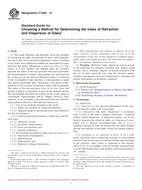
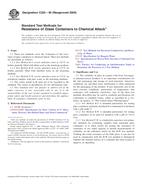 ASTM C225-85(2009)..
ASTM C225-85(2009)..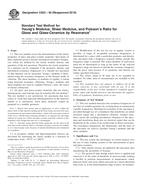 ASTM C623-92(2010)..
ASTM C623-92(2010)..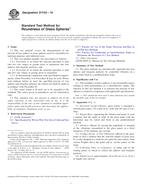 ASTM D1155-10
ASTM D1155-10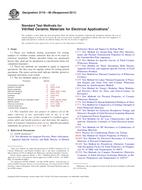 ASTM D116-86(2011)..
ASTM D116-86(2011)..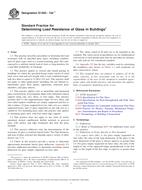 ASTM E1300-12ae1..
ASTM E1300-12ae1..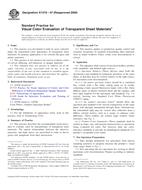 ASTM E1478-97(2009)..
ASTM E1478-97(2009)..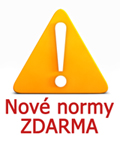
 Cookies
Cookies
